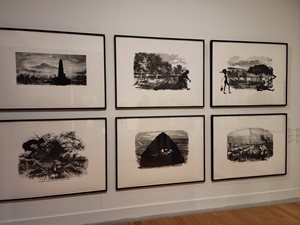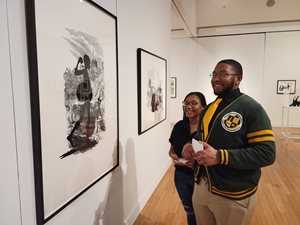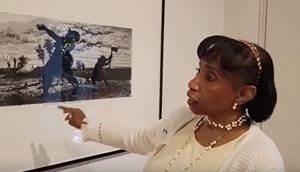 Kara Walker (b. 1969) is a renowned contemporary artist who is widely recognized for her incisive explorations of race, gender, and power. Her provocative and often controversial works challenge viewers to confront the darker aspects of American history and culture. One of her most significant exhibitions, "Cut to the Quick," is at the Virginia Museum of Contemporary Art (MOCA) from March 9 to June 11, 2023.
Kara Walker (b. 1969) is a renowned contemporary artist who is widely recognized for her incisive explorations of race, gender, and power. Her provocative and often controversial works challenge viewers to confront the darker aspects of American history and culture. One of her most significant exhibitions, "Cut to the Quick," is at the Virginia Museum of Contemporary Art (MOCA) from March 9 to June 11, 2023.
On Tuesday, April 18, Norfolk State University students, faculty, and staff gathered for NSU Night at Virginia MOCA, a joint event between the Robert C. Nusbaum Honors College and Virginia MOCA highlighting Walker’s “Cut to the Quick” exhibit. NSU scholars were stationed in the gallery to explain the significance of Walker’s art from the perspective of their areas of expertise. Viewers were encouraged to roam the gallery, view the artworks, and focus on four central areas of reflection for later.
 "Cut to the Quick" features over 60 pieces of Kara Walker's artwork, including her signature large-scale silhouette cutouts, drawings, paintings, and videos. The exhibition is organized thematically, with each section exploring a different aspect of the history and legacy of slavery. One of the most striking aspects of the exhibition was the way in which Walker uses the traditional form of the silhouette to subvert and challenge the conventions of this medium. Instead of portraying conventional images of the human form, Walker's silhouettes depict disturbing and often violent scenes of slavery and its aftermath.
"Cut to the Quick" features over 60 pieces of Kara Walker's artwork, including her signature large-scale silhouette cutouts, drawings, paintings, and videos. The exhibition is organized thematically, with each section exploring a different aspect of the history and legacy of slavery. One of the most striking aspects of the exhibition was the way in which Walker uses the traditional form of the silhouette to subvert and challenge the conventions of this medium. Instead of portraying conventional images of the human form, Walker's silhouettes depict disturbing and often violent scenes of slavery and its aftermath.
 Dr. Alexa Harris of NSU’s Department of History and Interdisciplinary studies described the event. Watch our YouTube video at https://youtu.be/uSw3a7eoRwU. Her reflective focus was “Centering Ourselves.” Viewers were encouraged to reflect on their identity and life experiences, then explore how they would center their existence with the compelling and challenging artwork of Kara Walker.
Dr. Alexa Harris of NSU’s Department of History and Interdisciplinary studies described the event. Watch our YouTube video at https://youtu.be/uSw3a7eoRwU. Her reflective focus was “Centering Ourselves.” Viewers were encouraged to reflect on their identity and life experiences, then explore how they would center their existence with the compelling and challenging artwork of Kara Walker.
Dr. Erica Russell of the NSU Department of Psychology was on hand to focus on the theme of “Beauty and Burden” asking viewers to ask the following question. “Is healing and wholeness a part of the Black women’s birthright or is self-sacrifice an expectation of their existence?”
Dr. Benadette Holmes of the NSU Department of Sociology encouraged viewers to reflect on the saying, “Womanism is to Feminism as Purple is to Lavender.” She asked “How might the artwork of Kara Walker reflect this conceptual distinction?
 Dr. Jackson of the NSU Department of Mass Communications and Journalism focused on “Mediated-Art” asking viewers “What is the impact and role of newspaper coverage on artwork created by African American artists?” In our YouTube video at https://youtu.be/ZBsKts6OZ6M, Dr. Jackson examines and observes how Kara Walker used Harper’s Weekly illustrations to superimpose her silhouettes as a commentary on white life after the Civil War and during westward expansion.
Dr. Jackson of the NSU Department of Mass Communications and Journalism focused on “Mediated-Art” asking viewers “What is the impact and role of newspaper coverage on artwork created by African American artists?” In our YouTube video at https://youtu.be/ZBsKts6OZ6M, Dr. Jackson examines and observes how Kara Walker used Harper’s Weekly illustrations to superimpose her silhouettes as a commentary on white life after the Civil War and during westward expansion.
.jpg.aspx?width=300&height=225) Participants later gathered in the Virginia MOCA auditorium to hear the scholars share more of their observations with students, faculty, and staff. Norfolk State University President Dr. Javaune Adams-Gaston opened the event remarking on the significance of NSU Night at Virginia MOCA and the importance of such partnerships throughout our community. Watch our YouTube video at https://youtu.be/KB6AEp_DosA.
Participants later gathered in the Virginia MOCA auditorium to hear the scholars share more of their observations with students, faculty, and staff. Norfolk State University President Dr. Javaune Adams-Gaston opened the event remarking on the significance of NSU Night at Virginia MOCA and the importance of such partnerships throughout our community. Watch our YouTube video at https://youtu.be/KB6AEp_DosA.
Please view our collection of photos from the event in our Flickr album at https://www.flickr.com/photos/nsu_spartans/albums/72177720307623031.
Kara Walker’s “Cut to the Quick” is on exhibit through June 11, 2023. The exhibit is provided from the collections of Jordan D. Schnitzer and his family foundation.